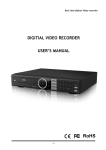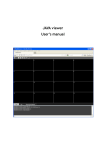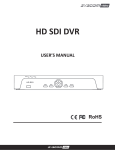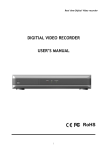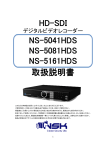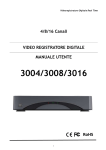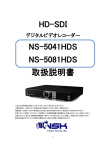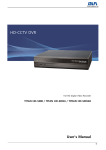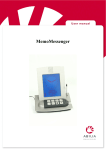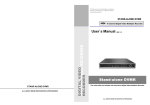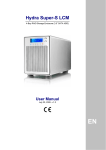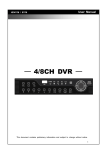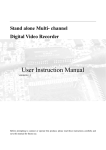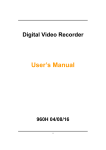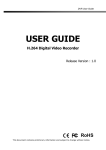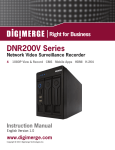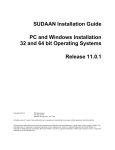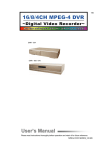Download HD SDI DVR
Transcript
HD SDI DVR USER’S MANUAL RoHS Important Safety Instructions Read and Keep these instructions Heed all warnings Follow all the instructions Do not use this apparatus near water and Clean only with dry cloth Do not install near any heat sources such as radiators, heat registers, or other apparatus that produce heat Protect the power cord from being walked on or pinched particularly at plugs, convenience receptacles, and the point where they exit from the apparatus. Unplug this apparatus. When a cart is used, use caution when moving the cart/apparatus combination to avoid injury from tip‐over. TO REDUCE THE RISK OF ELECTRIC SHOCK, DO NOT REMOVE. NO USER‐SERVICEABLE PARTS ARE INSIDE. REFER SERVICING TO QUALIFIED SERVICE PERSONNEL. The lightning flash with an arrowhead symbol within an equilateral triangle is intended to alert the user to the presence of uninsulated “ dangerous voltage” within the product’s enclosure that may be of sufficient magnitude to constitute a risk of electric shock to persons. . The exclamation point within an equilateral triangle is intended to alert the user to presence of important operating and maintenance (Servicing) instructions in the literature accompanying the appliance FCC For Class A digital device A CLASS A digital device that complies with Parts 15 of the FCC Rules. Operation is subject to the following two conditions. 1. This device may not cause harmful interference, and 2. This device must accept any interference received, Including interference that may cause undesired operations. Features This HD SDI(serial digital interface) DVR allows users to have HD level of video surveillance with 720P & 1080P resolution both in live and playback. Unlike megapixel IP cameras and NVR, it doesn’t require IP related expertise and can be installed under coaxial cabling. HD SDI DVR with H.264 compression HD video over coaxial cable : No latency & no loss of frame 120fps(PAL: 100fps) real time @ 720P, 60fps(PAL:50fps) @ 1080P HDMI, VGA and BNC video outputs VGA and BNC programmable spot outs Up to 4 internal SATA HDD (or 1 x ODD, 2 x HDD) and E‐SATA for external storage Individual channel setup for recording & network stream (resolution/frame rate) Event text + image notification to FTP server and E‐mail address Easy network : UPNP (Universal plug & play) support User control : Up to 20 users can be generated with various access authority Calendar/Time search & Thumbnail search Smart phone application (Live, PTZ, Search) ‐ 2 ‐ CONTENTS 1. Product Overview 1.1 Packing Contents ∙∙∙∙∙∙∙∙∙∙∙∙∙∙∙∙∙∙∙∙∙∙∙∙∙∙∙∙∙∙∙∙∙∙∙∙∙∙∙∙∙∙∙∙∙∙∙∙∙∙∙∙∙∙∙∙∙∙∙∙∙∙∙∙∙∙∙∙∙∙∙∙∙∙∙∙∙∙∙ 6 1.2 Front ∙∙∙∙∙∙∙∙∙∙∙∙∙∙∙∙∙∙∙∙∙∙∙∙∙∙∙∙∙∙∙∙∙∙∙∙∙∙∙∙∙∙∙∙∙∙∙∙∙∙∙∙∙∙∙∙∙∙∙∙∙∙∙∙∙∙∙∙∙∙∙∙∙∙∙∙∙∙∙ 7 1.3 Rear – 4ch DVR ∙∙∙∙∙∙∙∙∙∙∙∙∙∙∙∙∙∙∙∙∙∙∙∙∙∙∙∙∙∙∙∙∙∙∙∙∙∙∙∙∙∙∙∙∙∙∙∙∙∙∙∙∙∙∙∙∙∙∙∙∙∙∙∙∙∙∙∙∙∙∙∙∙∙∙∙∙∙∙∙ 8 1.4 Rear – 8ch DVR ∙∙∙∙∙∙∙∙∙∙∙∙∙∙∙∙∙∙∙∙∙∙∙∙∙∙∙∙∙∙∙∙∙∙∙∙∙∙∙∙∙∙∙∙∙∙∙∙∙∙∙∙∙∙∙∙∙∙∙∙∙∙∙∙∙∙∙∙∙∙∙∙∙∙∙∙∙∙∙∙ 9 2. Installing Product 2.1 Installing HDD ∙∙∙∙∙∙∙∙∙∙∙∙∙∙∙∙∙∙∙∙∙∙∙∙∙∙∙∙∙∙∙∙∙∙∙∙∙∙∙∙∙∙∙∙∙∙∙∙∙∙∙∙∙∙∙∙∙∙∙∙∙∙∙∙∙∙∙∙∙∙∙∙∙∙∙∙∙∙∙∙∙ 11 2.2 Connecting Camera and Audio Device ∙∙∙∙∙∙∙∙∙∙∙∙∙∙∙∙∙∙∙∙∙∙∙∙∙∙∙∙∙∙∙∙∙∙∙∙∙∙∙∙∙∙∙∙∙∙∙∙∙∙∙∙∙∙∙∙∙ 12 2.3 Connecting Monitor ∙∙∙∙∙∙∙∙∙∙∙∙∙∙∙∙∙∙∙∙∙∙∙∙∙∙∙∙∙∙∙∙∙∙∙∙∙∙∙∙∙∙∙∙∙∙∙∙∙∙∙∙∙∙∙∙∙∙∙∙∙∙∙∙∙∙∙∙∙∙∙∙∙∙∙∙∙∙ 12 2.4 Connecting Optional Device ∙∙∙∙∙∙∙∙∙∙∙∙∙∙∙∙∙∙∙∙∙∙∙∙∙∙∙∙∙∙∙∙∙∙∙∙∙∙∙∙∙∙∙∙∙∙∙∙∙∙∙∙∙∙∙∙∙∙∙∙∙∙∙∙∙∙∙∙∙ 13 2.5 Connecting Network ∙∙∙∙∙∙∙∙∙∙∙∙∙∙∙∙∙∙∙∙∙∙∙∙∙∙∙∙∙∙∙∙∙∙∙∙∙∙∙∙∙∙∙∙∙∙∙∙∙∙∙∙∙∙∙∙∙∙∙∙∙∙∙∙∙∙∙∙∙∙∙∙∙∙∙∙∙∙∙∙ 13 2.6 Connecting Power Supply ∙∙∙∙∙∙∙∙∙∙∙∙∙∙∙∙∙∙∙∙∙∙∙∙∙∙∙∙∙∙∙∙∙∙∙∙∙∙∙∙∙∙∙∙∙∙∙∙∙∙∙∙∙∙∙∙∙∙∙∙∙∙∙∙∙∙∙∙∙∙∙∙ 13 3.Controlling DVR 3.1 Remote control – basic description ∙∙∙∙∙∙∙∙∙∙∙∙∙∙∙∙∙∙∙∙∙∙∙∙∙∙∙∙∙∙∙∙∙∙∙∙∙∙∙∙∙∙∙∙∙∙∙∙∙∙∙∙∙∙∙∙∙∙∙∙∙∙∙∙∙ 14 3.2 Remote control – additional description ∙∙∙∙∙∙∙∙∙∙∙∙∙∙∙∙∙∙∙∙∙∙∙∙∙∙∙∙∙∙∙∙∙∙∙∙∙∙∙∙∙∙∙∙∙∙∙ 15 3.3 Mouse ∙∙∙∙∙∙∙∙∙∙∙∙∙∙∙∙∙∙∙∙∙∙∙∙∙∙∙∙∙∙∙∙∙∙∙∙∙∙∙∙∙∙∙∙∙∙∙∙∙∙∙∙∙∙∙∙∙∙∙∙∙∙∙∙∙∙∙∙∙∙∙∙∙∙∙∙∙∙∙∙∙∙∙∙∙∙∙∙∙∙ 16 4. Operation 4.1 Turning On ∙∙∙∙∙∙∙∙∙∙∙∙∙∙∙∙∙∙∙∙∙∙∙∙∙∙∙∙∙∙∙∙∙∙∙∙∙∙∙∙∙∙∙∙∙∙∙∙∙∙∙∙∙∙∙∙∙∙∙∙∙∙∙∙∙∙∙∙∙∙∙∙∙∙∙∙∙∙∙∙∙∙∙∙∙∙∙∙∙∙ 18 4.2 Initial Screen ∙∙∙∙∙∙∙∙∙∙∙∙∙∙∙∙∙∙∙∙∙∙∙∙∙∙∙∙∙∙∙∙∙∙∙∙∙∙∙∙∙∙∙∙∙∙∙∙∙∙∙∙∙∙∙∙∙∙∙∙∙∙∙∙∙∙∙∙∙∙∙∙∙∙∙∙∙∙∙∙∙∙∙∙∙∙∙ 18 4.3 Screen Layout ∙∙∙∙∙∙∙∙∙∙∙∙∙∙∙∙∙∙∙∙∙∙∙∙∙∙∙∙∙∙∙∙∙∙∙∙∙∙∙∙∙∙∙∙∙∙∙∙∙∙∙∙∙∙∙∙∙∙∙∙∙∙∙∙∙∙∙∙∙∙∙∙∙∙∙∙∙∙∙∙∙∙∙∙∙∙∙∙ 18 5. MENU 5.1 Access to menu ∙∙∙∙∙∙∙∙∙∙∙∙∙∙∙∙∙∙∙∙∙∙∙∙∙∙∙∙∙∙∙∙∙∙∙∙∙∙∙∙∙∙∙∙∙∙∙∙∙∙∙∙∙∙∙∙∙∙∙∙∙∙∙∙∙∙∙∙∙∙∙∙∙∙∙∙∙∙∙∙∙∙∙∙∙∙ 21 5.2 Setup Menu ∙∙∙∙∙∙∙∙∙∙∙∙∙∙∙∙∙∙∙∙∙∙∙∙∙∙∙∙∙∙∙∙∙∙∙∙∙∙∙∙∙∙∙∙∙∙∙∙∙∙∙∙∙∙∙∙∙∙∙∙∙∙∙∙∙∙∙∙∙∙∙∙∙∙∙∙∙∙∙∙∙∙∙∙∙∙∙∙∙∙ 21 5.2.1 Display ∙∙∙∙∙∙∙∙∙∙∙∙∙∙∙∙∙∙∙∙∙∙∙∙∙∙∙∙∙∙∙∙∙∙∙∙∙∙∙∙∙∙∙∙∙∙∙∙∙∙∙∙∙∙∙∙∙∙∙∙∙∙∙∙∙∙∙∙∙∙∙∙∙∙∙∙∙∙∙∙∙∙∙∙∙∙∙∙∙∙ 22 5.2.2 Camera ∙∙∙∙∙∙∙∙∙∙∙∙∙∙∙∙∙∙∙∙∙∙∙∙∙∙∙∙∙∙∙∙∙∙∙∙∙∙∙∙∙∙∙∙∙∙∙∙∙∙∙∙∙∙∙∙∙∙∙∙∙∙∙∙∙∙∙∙∙∙∙∙∙∙∙∙∙∙∙∙∙∙∙∙∙∙∙∙∙ 23 5.2.3 Record ∙∙∙∙∙∙∙∙∙∙∙∙∙∙∙∙∙∙∙∙∙∙∙∙∙∙∙∙∙∙∙∙∙∙∙∙∙∙∙∙∙∙∙∙∙∙∙∙∙∙∙∙∙∙∙∙∙∙∙∙∙∙∙∙∙∙∙∙∙∙∙∙∙∙∙∙∙∙∙∙∙∙∙∙∙∙∙∙∙∙ 26 ‐ 3 ‐ 5.2.4 Event ∙∙∙∙∙∙∙∙∙∙∙∙∙∙∙∙∙∙∙∙∙∙∙∙∙∙∙∙∙∙∙∙∙∙∙∙∙∙∙∙∙∙∙∙∙∙∙∙∙∙∙∙∙∙∙∙∙∙∙∙∙∙∙∙∙∙∙∙∙∙∙∙∙∙∙∙∙∙∙∙∙∙∙∙∙∙∙∙∙∙ 28 5.2.5 Storage ∙∙∙∙∙∙∙∙∙∙∙∙∙∙∙∙∙∙∙∙∙∙∙∙∙∙∙∙∙∙∙∙∙∙∙∙∙∙∙∙∙∙∙∙∙∙∙∙∙∙∙∙∙∙∙∙∙∙∙∙∙∙∙∙∙∙∙∙∙∙∙∙∙∙∙∙∙∙∙∙∙∙∙∙∙∙∙∙ 32 5.2.6 Network ∙∙∙∙∙∙∙∙∙∙∙∙∙∙∙∙∙∙∙∙∙∙∙∙∙∙∙∙∙∙∙∙∙∙∙∙∙∙∙∙∙∙∙∙∙∙∙∙∙∙∙∙∙∙∙∙∙∙∙∙∙∙∙∙∙∙∙∙∙∙∙∙∙∙∙∙∙∙∙∙∙∙∙∙∙∙∙∙ 34 5.2.7 System ∙∙∙∙∙∙∙∙∙∙∙∙∙∙∙∙∙∙∙∙∙∙∙∙∙∙∙∙∙∙∙∙∙∙∙∙∙∙∙∙∙∙∙∙∙∙∙∙∙∙∙∙∙∙∙∙∙∙∙∙∙∙∙∙∙∙∙∙∙∙∙∙∙∙∙∙∙∙∙∙∙∙∙∙∙∙∙∙∙∙ 37 5.3 Search ∙∙∙∙∙∙∙∙∙∙∙∙∙∙∙∙∙∙∙∙∙∙∙∙∙∙∙∙∙∙∙∙∙∙∙∙∙∙∙∙∙∙∙∙∙∙∙∙∙∙∙∙∙∙∙∙∙∙∙∙∙∙∙∙∙∙∙∙∙∙∙∙∙∙∙∙∙∙∙∙∙∙∙∙∙∙∙∙ 42 5.3.1 Search by Calendar ∙∙∙∙∙∙∙∙∙∙∙∙∙∙∙∙∙∙∙∙∙∙∙∙∙∙∙∙∙∙∙∙∙∙∙∙∙∙∙∙∙∙∙∙∙∙∙∙∙∙∙∙∙∙∙∙∙∙∙∙∙∙∙∙∙∙∙∙∙∙∙∙∙∙ 42 5.3.2 Search by Event ∙∙∙∙∙∙∙∙∙∙∙∙∙∙∙∙∙∙∙∙∙∙∙∙∙∙∙∙∙∙∙∙∙∙∙∙∙∙∙∙∙∙∙∙∙∙∙∙∙∙∙∙∙∙∙∙∙∙∙∙∙∙∙∙∙∙∙∙∙∙∙∙∙∙∙∙∙∙∙ 43 5.3.3 Thumbnail Search ∙∙∙∙∙∙∙∙∙∙∙∙∙∙∙∙∙∙∙∙∙∙∙∙∙∙∙∙∙∙∙∙∙∙∙∙∙∙∙∙∙∙∙∙∙∙∙∙∙∙∙∙∙∙∙∙∙∙∙∙∙∙∙∙∙∙∙∙∙∙∙∙∙∙∙∙∙∙∙ 43 5.3.4 Backup ∙∙∙∙∙∙∙∙∙∙∙∙∙∙∙∙∙∙∙∙∙∙∙∙∙∙∙∙∙∙∙∙∙∙∙∙∙∙∙∙∙∙∙∙∙∙∙∙∙∙∙∙∙∙∙∙∙∙∙∙∙∙∙∙∙∙∙∙∙∙∙∙∙∙∙∙∙∙∙ 44 5.3.5 Search mode ∙∙∙∙∙∙∙∙∙∙∙∙∙∙∙∙∙∙∙∙∙∙∙∙∙∙∙∙∙∙∙∙∙∙∙∙∙∙∙∙∙∙∙∙∙∙∙∙∙∙∙∙∙∙∙∙∙∙∙∙∙∙∙∙∙∙∙∙∙∙∙∙∙∙∙∙∙∙∙∙ 44 5.4 Other function ∙∙∙∙∙∙∙∙∙∙∙∙∙∙∙∙∙∙∙∙∙∙∙∙∙∙∙∙∙∙∙∙∙∙∙∙∙∙∙∙∙∙∙∙∙∙∙∙∙∙∙∙∙∙∙∙∙∙∙∙∙∙∙∙∙∙∙∙∙∙∙∙∙∙∙∙∙∙∙∙∙∙∙∙∙∙∙∙∙ 45 5.4.1 PTZ ∙∙∙∙∙∙∙∙∙∙∙∙∙∙∙∙∙∙∙∙∙∙∙∙∙∙∙∙∙∙∙∙∙∙∙∙∙∙∙∙∙∙∙∙∙∙∙∙∙∙∙∙∙∙∙∙∙∙∙∙∙∙∙∙∙∙∙∙∙∙∙∙∙∙∙∙∙∙∙∙∙∙∙∙∙∙∙∙∙ 45 5.4.2 Audio ∙∙∙∙∙∙∙∙∙∙∙∙∙∙∙∙∙∙∙∙∙∙∙∙∙∙∙∙∙∙∙∙∙∙∙∙∙∙∙∙∙∙∙∙∙∙∙∙∙∙∙∙∙∙∙∙∙∙∙∙∙∙∙∙∙∙∙∙∙∙∙∙∙∙∙∙∙∙∙∙∙∙∙∙∙∙∙∙∙∙∙∙∙ 46 5.4.3 Log View ∙∙∙∙∙∙∙∙∙∙∙∙∙∙∙∙∙∙∙∙∙∙∙∙∙∙∙∙∙∙∙∙∙∙∙∙∙∙∙∙∙∙∙∙∙∙∙∙∙∙∙∙∙∙∙∙∙∙∙∙∙∙∙∙∙∙∙∙∙∙∙∙∙∙∙∙∙∙∙∙∙∙∙∙∙∙∙∙∙∙∙∙∙∙∙∙∙∙∙ 46 5.5 OSD OFF ∙∙∙∙∙∙∙∙∙∙∙∙∙∙∙∙∙∙∙∙∙∙∙∙∙∙∙∙∙∙∙∙∙∙∙∙∙∙∙∙∙∙∙∙∙∙∙∙∙∙∙∙∙∙∙∙∙∙∙∙∙∙∙∙∙∙∙∙∙∙∙∙∙∙∙∙∙∙∙∙∙∙∙∙∙∙∙∙∙∙∙∙∙∙∙∙∙ 47 5.6 REC ∙∙∙∙∙∙∙∙∙∙∙∙∙∙∙∙∙∙∙∙∙∙∙∙∙∙∙∙∙∙∙∙∙∙∙∙∙∙∙∙∙∙∙∙∙∙∙∙∙∙∙∙∙∙∙∙∙∙∙∙∙∙∙∙∙∙∙∙∙∙∙∙∙∙∙∙∙∙∙∙∙∙∙∙∙∙∙∙∙∙∙∙∙∙∙∙∙∙ 47 5.7 Log Out Control ∙∙∙∙∙∙∙∙∙∙∙∙∙∙∙∙∙∙∙∙∙∙∙∙∙∙∙∙∙∙∙∙∙∙∙∙∙∙∙∙∙∙∙∙∙∙∙∙∙∙∙∙∙∙∙∙∙∙∙∙∙∙∙∙∙∙∙∙∙∙∙∙∙∙∙∙∙∙∙∙∙∙∙∙∙∙∙ 47 Specification ∙∙∙∙∙∙∙∙∙∙∙∙∙∙∙∙∙∙∙∙∙∙∙∙∙∙∙∙∙∙∙∙∙∙∙∙∙∙∙∙∙∙∙∙∙∙∙∙∙∙∙∙∙∙∙∙∙∙∙∙∙∙∙∙∙∙∙∙∙∙∙∙∙∙∙∙∙∙∙∙∙∙∙∙∙∙∙ 48 Trouble shooting ∙∙∙∙∙∙∙∙∙∙∙∙∙∙∙∙∙∙∙∙∙∙∙∙∙∙∙∙∙∙∙∙∙∙∙∙∙∙∙∙∙∙∙∙∙∙∙∙∙∙∙∙∙∙∙∙∙∙∙∙∙∙∙∙∙∙∙∙∙∙∙∙∙∙∙∙∙∙∙∙∙∙∙∙∙∙∙∙ 49 ‐ 4 ‐ 1. Product Overview ‐ 5 ‐ 1.1 Packing Contents When you first open the product, please check out whether there are all contents as follows. If any of these items is missing or damaged, contact your supplier immediately before using the product. DVR product Remote control & Battery Power adaptor and cable Software / User’s Manual CD 2 x HDD bracket (1 set included in set, 1 set is extra) 1 x DVD bracket (in set) Screws User’s Manual HDD Cable [Included in Set] ‐ 6 ‐ 1.2 Front 7 Number USB port 2 Channel 3 5 4 Name 1 6 3 2 Function Connect USB device to 2 ports Select numbers to select certain channel or input numbers in menu Menu Access to main menu Zoom Access directly to digital zoom mode (in Live & playback) Mode Change screen split mode Search Access directly to search menu PWR : Light on when power is on 4 LED indicator REC : Light on when DVR is recording NET : Light on when a user is connected via network Direction & Select directions in menu Selection keys Play, FF(fast‐forward), RW(rewind), stop/pause buttons 6 DVD open/close Open or close DVR door 7 DVD door DVD door 5 ‐ 7 ‐ 1 1.3 REAR – 4ch DVR 1 2 Number 4 Name 5 10 7 9 11 Function Turn on/off the product 2 DC 12V Connect power adaptor provided with the product 3 AUDIO OUT Connect audio out device such as speaker 4 VGA VGA connection port 5 HDMI HDMI connection port SENSOR Sensor input ports ALARM Alarm output ports RS‐485 RS‐485 communication 7 E‐SATA E‐SATA port 8 ETHERNET 10/100MB or 1GB LAN port 9 HD SDI HD SDI type video in AUDIO IN Connect audio in device such as MIC VIDEO OUT Composite video out (BNC type) SPOT (BNC) Spot out (BNC type) SPOT VGA Spot out (VGA type) 10 11 12 Power switch 6 3 8 1 6 12 ‐ 8 ‐ 1.4 REAR – 8ch DVR 1 2 Number Name 5 7 8 9 12 11 Function Power switch Turn on/off the product 2 DC 12V Connect power adaptor provided with the product 3 AUDIO OUT Connect audio out device such as speaker 4 VGA VGA connection port 5 HDMI HDMI connection port SENSOR Sensor input ports (8 ports) ALARM Alarm output ports (4 ports) RS‐485 RS‐485 communication 7 E‐SATA E‐SATA port 8 ETHERNET 10/100MB or 1GB LAN port 9 VIDEO OUT Composite video out (BNC type) 10 AUDIO IN Connect audio in device such as MIC 11 HD SDI HD SDI type video in 12 SPOT (BNC) Spot out (BNC type) 13 SPOT VGA Spot out (VGA type) 6 4 10 1 3 6 ‐ 9 ‐ 13 2. Installing Product HD SDI 4ch DVR SYSTEM CONFIGURATION ‐ 10 ‐ 2.1. Installing HDD Up to 4 hard drives (without DVD RW) can be installed inside the product. If HDD was not installed in the product, please install HDD first as follows. Be careful not to be harmed by sharp edges of the product. (1) Loosen screws on both sides and back to detach the product cover. (2) Lift the end of top cover and pull out from product. (3) Loosen screws of HDD bracket to detach from (4) Restore HDD bracket to product and product. Put HDD in HDD bracket and tighten connect HDD power cable and data cable to supplied 4HDD screws to bracket. HDD. (5) Insert top cover to product as side picture Them, tighten screws again. ‐ 11 ‐ 2.2. Connecting camera and audio device Connect coaxial cable (BNC type) into VIDEO IN port on rear of the product. HD SDI cabling specification: SMPTE 292M standard, 5C‐HFBT or above Connect RCA cable from microphone into AUDIO IN port on rear of the product. Connect RCA cable into AUDIO OUT port on rear of the product and into audio device. HD SDI video input Audio IN Audio OUT 2.3. Connecting monitor Connect monitors into the video out ports of the product according to interface. VIDEO OUT (BNC) 1 x video out, 1 x spot VGA OUT 1 x video out, 1 x spot 1 x HDMI OUT ‐ 12 ‐ 2.4. Connecting Optional device You can connect and control the PTZ device supporting RS‐485 communication. 2.5. Connecting Network Connect LAN cable (RJ45) to Ethernet port on rear of the product. LAN cable (RJ45) 2.6. Connecting power supply Connect provided power cable to AC‐DC adaptor. Connect the adaptor to DC power port on rear of the product. Connect AC power plug to the plug socket. ‐ 13 ‐ 3.Controlling DVR 3.1. Remote control – Basic description 1) REC : Instant record button 2) DVR ID 3) Number button : Input channel number 1 2 4) AUDIO : Audio ON / Mute 5) BACKUP : Access directly to backup menu 6) MENU : Access to main menu 7) OSD : Show or Hide OSD 3 8) PTZ : Control Pan/Tilt/Zoom camera. 9) Z/F: Access to digital zoom mode 8 4 5 10) Direction (▲,▼,◀,▶) & ENTER 7 11) SEARCH : Search recorded video 9 6 12) LOG : Show running status of DVR system 10 11 14 15 13 12 19 20 24 22 23 16) ■ : Stop playback and go to Live mode 17) SPOT : Not Operated in this model 17 21 14) ▶I : Play or Pause during playback 15) ▶▶ : Fast forward play 16 18 13) ◀◀ : Reverse play 18) PIP : Go to PIP mode 19) POP : Enlarge specific channel in Live mode 20) SEQ : Show each camera rotation 21) Full screen mode 22) Quad screen mode 23) 9 Division screen mode Operated only for 8ch or 16 channels 24) 16 Division screen mode Operated only for 16 channels ‐ 14 ‐ 3.2. Remote control – Additional descriptions 3.2.1. Full screen mode ‐ Press button. Whenever pressing button, screen will go to next screen. ‐ Press desired numeric button of remote controller. 3.2.2. Quad screen mode ‐ To see quad screen mode, press button. 3.2.3. OSD Hide or Show ‐ Press OSD button of remote controller to appear or disappear OSD. 3.2.4. Sequence mode ‐ If you press SEQ button in Full screen split, screen will rotate automatically. ‐ Default value of cannel rotating interval is 2 or 3 seconds. ‐ User can select changing interval value from 1 to 99 seconds. ‐ User can select desired channel to display ‐ 15 ‐ 3.2.5. Digital‐ZOOM DVR supports up to 10 times (x10) digital zoom Select ZOOM icon o or ZOOM button on remote control Using mouse, drag certain area to enlarge image To disable to digital zoom mode, mouse right‐click Normal mode Digital zoom mode x10 3.3. MOUSE System supports USB MOUSE Just Insert USB mouse into the product, then DVR will detect it automatically. Inquire your supplier if certain USB mouse doesn’t work properly. 3.3.1. Change screen mode Mouse left‐click is for selecting an item on menu. Right‐click in live goes to main menu. z Double left‐click on a specific channel, screen will change into full screen mode. With double‐click in full screen mode, screen will go back to previous mode. ‐ 16 ‐ 4. Operation ‐ 17 ‐ PLEASE MAKE SURE THAT THE HDD MUST BE INSTALLED AT FIRST FOR RECORDING BEFORE USING DVR. 4.1. Turning on Connect Power Adaptor provided with the product into power DC terminal. Press ON of the switch button in the rear of product. 4.2. Initial screen Log‐in window will pop up after booting is over. Please move the pointer into password window with mouse or up/down key of remote controller, and then press enter button in remote control or right button of mouse. If you first start DVR, input Initial password is “0000” (4 zeros). After first login, it is recommended that you change password. In order to change password, please refer to page 39, USER. 4.3. Screen Layout You can see the below items according to your selection on function. ‐ 18 ‐ 4.3.1. Icons in Live Display Mode In Live display mode, icons will be indicated to notify the system mode or status. Below are the icon categories, which are indicated on the monitor. Icon for system Icon for each channel Selects specific 1ch with full screen When Motion Detected Screen‐Division mode When Sensor Activated Start/stop Panic(manual) record Channel with audio connected HDD capacity usage status When PTZ mode entered When USB memory stick & HDD is When channel is recording inserted into DVR When DVR is connected via network When panic record is activated When DVR is not connected via network System ID for remote control Check auto‐backup with external USB HDD (status, capacity) Icon in full screen mode Channel sequence mode Digital x10 Zoom ‐ 19 ‐ 4.3.2. Controlling playback using the buttons In search mode, the status will be shown in the upper side of screen. You can control playback using the buttons. - This icon shows the current status in playback. Current status - If you select ▶, the mark will be ▶, - The mark will be changed if you select another button Ex) If you select FF (fast‐forward), ▶▶ will be shown. Backward ‐ Select backward and control speed (x2, x4, x8, x32 and x128) ‐ In pause status, this button moves frame by frame reversely Play ‐ Play button. Select this button in pause mode Pause ‐Pause button. Select this button in play, rewind or FF mode. Fast Forward Stop Search menu Digital zoom ‐ Select fast‐forward and control the speed (x2, x4, x8, x32 and x128) ‐ In pause status, this button moves frame by frame forward. Stop the playback and go to Live mode Menu button also stop playing. ‐ Selecting this button, the Search sub‐menu will pop up ‐Digital zoom button in playback. Select this button to 1ch full screen mode Play speed ‐Indicates speed of rewind or fast‐forward Backup ‐Access to backup function. ‐ 20 ‐ 5. MENU 5.1. Access to menu Press MENU button on front keys/remote control or right‐click using mouse. Before access to main menu, DVR asks you login ID and password. When you first start DVR, input ADMIN for ID and 0000 for password as Initial ID & password are ADMIN & 0000 respectively. 5.2. SETUP *Sub menus of SETUP DISPLAY CAMERA RECORD STORAGE EVENT SYSTEM OSD GENERAL PARAMETER MOTION HDD FORMAT CONFIG LIVE‐SEQ(FULL) PTZ SCHEDULE SENSOR HDD SMART TIME PRESET GENERAL VLOSS AUTO BACKUP INPUT DEVICE SCAN POINT E‐MAIL FTP MAIL SCHEDULE SET UP ALARM SCHEDULE STREAM FTP SCHEDULE DDNS MISC ‐ 21 ‐ USER NETWORK UPGRADE TURN OFF DVR 5.2.1. DISPLAY Configurations related to OSD can be made in OSD menu. Sequence patterns of main and spot monitors can be programmed in LIVE‐SEQ menu. 5.2.1.1. OSD Select OSD items that displays on monitor and select language. CAMERA NAME ‐ Show camera name on screen. CAMERA NUMBER – Show each camera numbers on the screen. CAMERA BOARDER – Show outline of channel. LANGUAGE – Select OSD language. OSD HIDE – Option: ALL, time bar or icon AUTO HIDE – Hide ALL, time bar or icon automatically after time‐out (minute) 5.2.1.2. LIVE‐SEQ(FULL) LIVE SEQUENCE: Set order of sequence channel and dwell time by second for main video out. SPOT SEQUENCE: Set order of sequence channel and dwell time by second for spot out DEFAULT: Go back to initial value ALL TIME: Apply same time for all channels Maximum time is 99 second ‐ 22 ‐ 5.2. 2. CAMERA General camera configurations such as camera name, color and covert can be made. Private zone on certain cameras can be designated. PTZ configurations can be made. 5.2.2.1. GENERAL NAME: Input name of each camera using virtual keyboard. Maximum 15 digits in English can be used. COVERT: Show or hide camera image in live mode ON: Hide camera, OFF: show camera AUDIO: Select connected audio channel How to input letters or numbers on TEXT INPUT box Move the pointer to the name box (Blank) and click. Click letters or numbers with direction button. Click OK button after you complete input. ‐ 23 ‐ 5.2.2.2. PTZ ID: Input ID of connected PTZ camera PROTOCOL: Select protocol type of PTZ camera BAUD: Select baud rate of PTZ camera This information can be found in manual of PTZ camera. 5.2.2.3. PRESET CAMERA: Select camera to set up preset position PAGE: Go to next page CLEAR ALL: Cancel all saved presets. ① Select camera. ② Select “SET” button. ③ PTZ control screen of the camera will appear. ④ Move pan, tilt, zoom in/out to desired point. ⑤ Click Advance icon or Press ENTER Key in remote controller to save. ⑥ Click any other position on screen by mouse or press MENU Key to cancel. If you like to cancel the setting, please click the CLE icon of the channel will be cleared. If you click “CLEAR ALL” button, all value of channels will be cleared. NOTE: Before using this function, please make sure that camera supports preset. Total 64 preset points can be saved to each channel. You can enter position name to each saved preset position. ‐ 24 ‐ 5.2.2.4. SCAN POINT CAMERA: Select camera to set up scan point LIST: Create another SCAN list PRESET: Select desired preset potion CLEAR ALL: Cancel all saved scan points NOTE In SCAN point menu, you can set up PTZ tour route(SCAN‐LIST) using saved PRESET position. You can create 4 scan lists for each camera. You should setup PTZ protocol and PRESET before setting Scan‐List. Maximum 4 SCAN lists can be set and 1 SCAN list can be composed of up to 16 preset points ¾ Example If SCAN POINT is set as left, CAMERA 1 will move to saved positions as below, PTZ04 (stays for 3sec) >> PTZ12 (stays for 3sec) >> PTZ04 (stays for 3 sec) >> PTZ12 (stays for 3 sec) >> PTZ04 (stays for 3 sec) >>…… ‐ 25 ‐ 5.2.3. RECORD Recording setup such as parameter, schedule and pre/post recording can be made in RECORD menu. 5.2.3.1. PARAMETER Recording resolution CAMERA INPUT RESOLUTION 720P 1280 X 720 1080P 1920 080 Resolution ‐Recording resolution is determined automatically by HD SDI camera input and cannot be changed. EVENT ‐ Select the recording picture quality and frame rate for EVENT occasions. ‐ Event occasions mean when motion is detected or alarm is triggered. ‐ Each channel can have separate picture quality and frame rate. CONTINUOUS ‐ Select the recording picture quality and frame rate for continuous recording. ‐ Each channel can have separate picture quality and frame rate ‐ The frame rate in CONTINOUS cannot exceed that of Event mode. If the frame rate of EVENT is set up as 8, and that of CONTINUOUS mode cannot exceed 8. ALL Apply the same picture quality & frame rate for all channels. ‐ 26 ‐ NOTE: When connecting 720P camera, please make sure you turn off DVR and hook camera cable to DVR Otherwise, the unit will not recognize 1280x720 resolution and cause recording problem. NOTE: The higher recording quality, the more HDD drive space needed. Record Quality Picture Quality Disk Space Need BASIC Low Least NORMAL Fair Medium HIGH Good Big BEST Excellent Most 5.2.3.2. SCHEDULE DVR always records according to schedule. Please make sure to set recording schedule during installation REC OFF: No record, just monitor during selected hours. CONTINUOUS REC: DVR records continuously during selected days and hours. EVENT REC: DVR records only when Motion/Sensor/Video Loss is triggered during selected hours. CONTINUOUS + EVENT REC: DVR records continuously or by events during selected days and hours. If there is no event, it will record video as continuous mode and If there is event, it will record video as event mode as you set. If you use mouse, you can select them by drag function. NOTE: Recording schedule can be set by hour. The time in the first column of each line means 00:00 ~00:59. ‐ 27 ‐ 5.2.3.3. General OVERWRITE: When HDD gets full, the oldest record data will be erased and replaced (overwritten) by new data. ON: Use OVERWRITE, OFF: Not use OVERWRITE If it is set OFF, DVR stops recording when HDD gets full. AUTO‐DELETE: HDD only keeps the data of selected PRE‐REC TIME: Recording time before events (0~5 sec) POST‐REC TIME: Recording time after events (0~120 sec) WATER‐MARK: Generate water‐mark in recording data Authenticity can be verified in backup‐ viewer software. 5.2.4. EVENT Configurations regarding events can be made. ‐ 28 ‐ 5.2. 4.1. MOTION CAMERA: Select camera for motion setup SENSITIVITY: Adjust motion sensitivity from 0~9 The higher number, the more sensitive detection ALARM‐OUT: Select alarm‐out number which will be triggered when motion is detected. RECORD CH: Select channels which will record when motion is detected. BUZZER: Set ON/OFF for buzzer when motion is detected NIGHT MODE: Set separate sensitivity for day and for night. This option can be used in order to avoid false motion event caused by camera noise at night. SET ALL: All area (8x8 Grid) will be enabled for motion detection. CLEAR ALL: All area (8x8 Grid) will be disabled for motion detection. 5.2.4.2. SENSOR TYPE: Select NO(Normal open)/NC(Normal closed) RECORD: Select camera channels which will record when sensor is activated. ALARM‐OUT: Select alarm‐out number which will be triggered when sensor is activated. BUZZER: Set ON/OFF for buzzer when sensor is activated. 5.2.4.3. VLOSS ALARM‐OUT: Select alarm‐out numbers that will be triggered when video loss occurs. BUZZER: Set ON/OFF for buzzer when video loss occurs. ALL: Apply the same settings to all channels. ‐ 29 ‐ 5.2.4.4. E‐MAIL DVR can send e‐mail notification when events occur. EVENT E‐MAIL: Select ALL time or SCHEDULE for email notification IMAGE: Check the box then DVR sends image as well as text when events occur. EVENT TYPE: Select event type from MOTION, POWER ON, SENSOR, HDD ERROR, VLOSS SENDER ID: DVR sends email with this name E‐MAIL ADDRESS: Input up to 2 email addresses. ¾ Example: [email protected] SECURE TYPE ‐NORMAL: Standard email transfer, Port 21 ‐SSL(485): Secure email transfer, Port 485 ‐TLS(587): Secure email transfer, Port 587 SERVER NAME: In case of using SSL or TLS, input SMTP server name ID/PASSWORD: In case of using SSL or TLS, input ID and password of SMTP server NOTE: You can find SMTP server information usually from POP3/SMTP, IMAP/SMTP setup menu of the server. Otherwise, you need to ask the server manager. ¾ EXAMPLE: If you have an account in Gmail, Input smtp.gmail.com in SERVER NAME and ID/PASSWORD of your Gmail account. If normal is selected, you don’t need to input in SERVER NAME and ID/PASSWORD. ¾ EXAMPLE: Email message From : [email protected] To : [email protected] Sent: Friday, July 24, 2011 6:11 PM Subject: EVENT MESSAGE [2011/07/24 18:10:11] [testdvr/192.168.001.121] MOTION ch 1 ON ‐ 30 ‐ 5.2.4.5. FTP DVR can send text + image to designated FTP server when events occur. FTP: Select OFF,TEXT or TEXT + IMAGE EVENT TYPE: Select event type to send to FTP. FTP address: Input IP address or domain name of FTP server. Account ID: Input ID to access FTP server Account PW: Input password to access FTP server Directory Name: Directory of FTP server that will save transferred text or image PORT: Input port number to use transfer to FTP FTP normal uses port 21. 5.2.4.6. E‐MAIL/ALARM/FTP SCHEDULE Make a schedule for e‐mail transfer, alarm‐out and ftp transfer for events. Schedule can be arranged by day and by hour. Only during checked day and time, e‐mail will be sent and alarm‐out will be activated and ftp transfer will work. E‐Mail schedule: Select day & hour (Mouse drag/drop) Alarm‐out schedule: Select day & hour (Mouse drag/drop) FTP schedule: Select day & hour (Mouse drag/drop) 5.2.4.7. MISC DWELL TIME: Dwelling time for alarm‐out EVENT POPUP: Channel where event occurs pops up in full screen mode. POPUP OUT NORMAL: Popup in main monitor SPOT: Popup in spot monitor POPUP SEQUENCE TIME: Popup dwelling time ‐ 31 ‐ Note: if event occurs during dwell time of another event, dwell time will be ignored and newer event will pop up 5.2.5. STORAGE Up to 4 internal hard drives can be installed in the unit. Additionally 1 E‐SATA hard drive can be attached to the unit using E‐SATA port in the rear. 5.2.5.1. HDD FORMAT HDD must be formatted when installed in order to record properly. Select HDD to format and click FORMAT button. When format is completed, DVR will reboot automatically. Time to format can be different depending on size of HDD but it usually takes a few minutes to complete. E‐SATA information is always indicated after internal hard drive(s). ‐ 32 ‐ 5.2.5.2. HDD SMART Temperature of HDD can be checked. If the temperature gets higher than certain point, DVR can notify user of that. Select ON in SMART TEMPERATURE THRESHOLD Set the limit temperature of HDD INSPECTION CYCLE Set the interval to check HDD temperature Options: Every 10 minutes, Hourly and Daily DAILY TIME In case you select “Daily” in inspection cycle, set time to check HDD temperature during a day. ALARM OUT Select alarm out ports which will activate when HDD temperature exceeds over set temperature threshold. BUZZER: Select ON/OFF of buzzer sound when HDD temperature exceeds over set temperature threshold. 5.2.5.3. AUTO‐BACKUP TYPE Once USB HDD is connected to DVR, HDD status is indicated. Recording file list can be checked by selecting SHOW. EXTEND: When internal HDD(s)(including E‐SATA HDD) gets full, HDD starts to overwrite and eldest data will be erased from internal HDD and saved in USB HDD at the same time. MIRROR: Same data of internal HDD will be recorded in USB HDD INTERNAL: To use this function, internal HDD and E‐SATA must be installed. Internal HDD and E‐SATA will have the same data as RAID 1. ‐ 33 ‐ 5.2.6. NETWORK 5.2.6.1. SETUP TYPE: Select network type among STATIC, DHCP and ADSL(PPPOE) DHCP: DVR automatically gets IP address, gateway and subnet mask. STATIC: Check your network environment and input IP address, gateway and subnet mask manually. ADSL: Input PPPOE ID and PASSWORD. MOBILE PORT: Port that is used for jpeg transfer Smart phone application uses this port. CLIENT PORT: Port that CMS uses. WEB‐PORT: Port that web viewer uses. All the ports numbers can be input from 0001~9999. Each port must not have identical port numbers. BANDWIDTH: Control up to unlimited bandwidth AUTO port forwarding: Check port forwarding for network connection from outer network. Router itself should support UPNP function ‐ 34 ‐ 5.2.6.2. STREAM When dual stream is activated, DVR sends separate network stream of resolution, picture quality and frame rate. When dual streaming is set OFF, DVR should send stream according to resolution, picture quality and frame rate set in recording parameter. According to HD SDI video input resolution (1080P or 720P), 1080P supports 960*540 & 480*270 for network resolution and 720P supports 640*360 & 320*180 for network resolution. Resolution Normal Frame 960*540 Basic 1, 2, 480*270 Normal 4, 8, 640*360 High 15, 30 320*180 Best 5.2.6.3. DDNS DVR supports DDNSCCTV.COM, DDNSCCTV(AUTO), DYNDNS.COM and NO‐IP.COM for DDNS connection. z Using DDNSCCTV.COM(AUTO) If you choose DDNSCCTV.COM(AUTO) in SERVER, DVR creates HOST NAME using DVR using MAC address of DVR. 1) Click DDNSCCTV.COM(AUTO) in SERVER 2) Then USER ID, PASSWORD and HOST NAME are generated automatically using MAC address. 3) USER ID, PASSWORD and HOST NAME are formed in DVR + last 6 letters of MAC address EX) If MAC address of DVR is 00:0E:B5:02:8A:5F, USER ID & PASSWORD are dvr028a5f and HOST NAME is dvr028a5f.ddnscctv.com z Using DDNCCTV.COM, DYNDNS.COM or NO‐IP.COM SERVER: Select DDNS server USER ID: Input DDNS server account ID PASSWORD: Input DDNS server account password HOST NAME: Input domain(host) name that you made at DDNS server CONNECT: Click the button to check connection to DDNS server. If connection is ok, STATUS shows DDNS OK ‐ 35 ‐ NOTE: To use DDNS function, you must first go to www.ddnscctv.com, www.dyndns.com or www.no‐ip.com on PC and create an account and make a domain (host) name. NOTE: If DDNS connection fails, check if all information has been input correctly (especially USER ID and PASSWORD) and check network status. How to register DDNSCCTV Input http://ddnscctv.com on web browser of PC to use DDNS service before you make configuration on DVR Click Registration button if you don’t have an account. Fill in E‐mail address, password, name and etc. Then, click Submit button Input domain name you wish to create and click Request Domain button. Domain name can be created with combinations of alphabets, numbers and marks. (You must not put a mark on first letter of domain name.) Click Logout button after domain name has been successfully registered. You can sign in with E‐mail and password you registered. ‐ 36 ‐ DDNS setup on DVR ① Move to SETUP Æ NETWORK Æ DDNS ② Select DDNSCCTV.COM (3 options : DDNSCCTV.COM, NO‐IP.COM, DYNDNS.COM) ③ Input E‐mail address & password you registered at http://ddnscctv.com on USER ID and PASSWORD. ④ Input domain name you registered at http://ddnscctv.com on HOSTNAME. DDNS use Input domain name you registered on web browser. ¾ Example: http://abc.ddnscctv.com For WAN connection, DVR web port/client port should be forwarded. (Port‐forwarding) In this case, input : (colon) web port. ¾ Example: If web port is set 1000 on DVR, http://abc.ddnscctv.com:1000 5.2.7. SYSTEM Configurations for time, user and etc. can be made. Software version can be checked and upgrade process can be made. ‐ 37 ‐ 5.2.7.1. CONFIG System setting values from one DVR can be copied to others. Insert USB device into USB port of DVR to import (load) or export (save) the setting values. CONFIG IMPORT & CONFIG EXPORT can be used to make several DVRs to have the same setting values. CONFIG IMPORT: Load the saved configuration file from USB device CONFIG EXPORT: Save the configuration file to USB device to copy it to another DVR DEFAULT: Change all configuration values back to factory default. 5.2.7.2. TIME DATE FORMAT: Select date format YY/MM/DD MM/DD/YY DD/MM/YY TIME FORMAT: 24HOURS or AM/PM TIME ZONE: Select time zone of your location TIME SYNC: System time will be synchronized with selected time server if it is turned ON. SERVER IP: Input IP or domain name of time server. Click TEST if connection with time server is OK. DVR checks time server for correct time every 1 hour. Example: time.bora.net (OK), http://time.bora.net (NOT OK) 5.2.7.3. INPUT DEVICE SYSTEM‐ID: Input the number that you want to register in this DVR. KEYBOARD: DVR system can be connected with control keyboard. KEY‐TONE: Beep whenever button is pressed if ON is selected. ‐ 38 ‐ How to set up System‐ID status System‐ID status shows whether the system will accept key from remote‐control or not. SYSTEM‐ID is used when user operates several systems with one remote control. SYSTEM‐ ID will be displayed when SYSTEM‐ ID is other than 0(zero). By using DVR‐ID button of remote control, remote control can be matched with SYSTEM‐ ID, or if SYSTEM‐ ID is 00, system‐ID is not displayed and system accept key from remote controller. If SYSTEM‐ ID color is Yellow, the system accepts remote‐control key input. If SYSTEM‐ ID and Active‐ID are not matching, SYSTEM‐ ID color will be Red and the system does not accept remote‐controller key input.(No beep) How to match SYSTEM‐ ID by remote controller (1) Press DVR‐ID button of remote controller.(You can hear short double‐beep.) (2) Then, press desired System‐ID by using 2 numeric button. (E.g. 02 or 03 or 01) Not working R : 01 Active ID : 02 Working R : 02 R : 03 Not working 5.2.7.4. USER There are 2 fixed users, ADMIN & NETUSER. Their name & access authority cannot be changed. Additionally, you can create up to 20 more users and give different access authority level to each user. USER – There are two unchangeable user IDs (ADMIN, NETUSER), to create new user or modify settings of existing users, click arrow button. ‐ 39 ‐ PASSWORD – Initial password for each user is set ‘0000’. When you create a new user, make sure that you have to enter new password and do not forget the newly input password. Up to 8 digits of numbers can be used for password (EX: 123456) SETUP – Check this box then the user is authorized to go into setup menu DVR FUNCTION– Click DVR function button of REC (Recording setup), PLAY (SEARCH), BACKUP and PTZ (Control) to give each user access authority. NETWORK – Check this box then the user is authorized to access to DVR via network (Web, CMS or mobile) COVERT CH – Select covert channels by each user. Marked channels will be hidden by the user TIME OUT – When this is set to ON, LOGIN window will re‐appear after entered time from any signal input. If you want to log out, you need to go to MENU and select LOG OUT like right picture. MONITOR – First select ON to give monitoring authority to each user. Then click CH button to Select monitoring channel the user can access. 5.2.7.5. UPGRADE You can check version information of software and firmware upgrade can be done. USB upgrade: Upgrade using USB device Network upgrade: Upgrade via network USB UPGRADE Please select USB upgrade in upgrade window ① Copy provided firmware file to your USB memory stick ② Insert USB Memory which includes Firmware into USB Port. ‐ 40 ‐ ③ Enter UPGRADE button to upgrade firmware, then small windows will appear. ④ Please click OK Icon and the message dialogue to confirm will popup, ⑤ And please click OK, or CANCEL to proceed. ⑥ It will take some minutes to upgrade, and then DVR will be rebooted automatically after upgrade is finished. Network upgrade Please select network upgrade in upgrade window ① Check out whether Server IP and FILE NAME are correct. If shown information is wrong, correct SERVER IP and FILE NAME and press ENTER button to input new information by text input Dialog box. NOTE : Make sure the information of Server IP & File name through your supplier. ② Select OK and press ENTER button to start S/W upgrade. After completing upgrade, the system will reboot automatically. 5.2.7.6. TURN OFF DVR Select TURN OFF DVR and software of DVR will be shutdown. In order to completely shut down DVR, turn off the power switch in the rear. ‐ 41 ‐ 5.3. SEARCH Time search using calendar/time bar and event search using event logs are supported. 5.3.1. SEARCH BY TIME Select date on calendar Select hour & minute on time bar Data on minutes is displayed by ALL and each channel Click “PREVIEW” button after selecting minute and channel no. on then playback of that channel starts on the small window. Click “PLAY” while running preview and it enlarges into full screen. To watch playback without preview, just click “PLAY” after selecting minute. GOTO FIRST/ GOTO LAST: Playback of earliest data/ latest data. NOTE: Dates with recording data are indicated in yellow. Hour/minute with recording data are indicated in bright blue ‐ 42 ‐ 5.3.2. SEARCH BY EVENT Select DATE & TIME to get event logs Select CH to get event logs Select EVENT TYPE to get event logs Select SEARCH button and event log list will be written. <PGUP, >PGDN: Page up & down of list <<FIRST, >>LAST: Go to first page or last page of list Click an event log on list then DVR goes to the time when the event happens in search mode. 5.3.3. THUMBNAIL SEARCH Thumbnail search is effective and quick search option. You can search recorded file of certain channel by displaying 9 screens at a time by selected time interval. CH: Select channel number to view. TIME: Select time to start “Thumbnail search” INTERVAL: Select time interval from 1 sec, 10sec to 1 minute & 1 hour. VIEW: Capture image by selected interval starting from selected time shows up If 1 hour is selected, each screen shows by 1 hour of the same channel. NEXT, PREVIOUS: Previous or next page of recorded file by selected interval Seeing the capture image, double‐click on certain screen then it will be divided in smaller interval. If you set 10:00AM in TIME and 1 hour in INTERVAL then first screen shows 10:00AM and second 11:00AM. Double‐click on second channel and it will be divided again in 9 screens by 10 minute (1 minute, 10 seconds and 1 second) starting from 11:00AM. ‐ 43 ‐ 5.3.4. BACKUP Recorded data can be archived in USB device or CD/DVD using backup function First, insert USB device or CD/DVD and select backup menu from main menu or press backup button on remote control and below popup will show up. DEVICE: Select device for backup CHANNEL: Select channel(s) to archive To AVI: Data will be archived in AVI format If unchecked “To AVI”, data will be archived in PS format and backup viewer program will be automatically copied. TIME STAMP: Insert time stamp into AVI file FROM/TO: Input starting time & ending time Without having to input time directly, 1 minute ~ 60 5.3.5. SEARCH MODE minutes of backup can easily be made. When DVR is in search mode, you can play, pause, rewind & fast‐forward (x2, x4, x8, x32 and x128) If you move mouse cursor at the bottom of screen, time bar pops up and you can drag and move the time in the bar. Time bar contains 24 hours and time of recording data is indicated in brighter blue. For more detailed description of icons, please refer to page 20, 4.3.2. Controlling playback using the buttons ‐ 44 ‐ 5.4. Other functions PTZ, backup, log view and audio settings can be made 5.4.1. PTZ If you press P/T button of remote control or select PTZ in main menu, screen will be changed to FULL screen mode and you can control PTZ camera. If you press advance button in PTZ window, PTZ‐ ADVANCE window will pop‐up. 5.4.1.1. PTZ BASIC Press ◀▶▲▼ button and camera will pan to left / right or tilt up / down. Press ◀◀ / ▶▶ button or search / log button of remote control or click (+), (‐) button and camera will zoom in or out. Press numeric button of remote control and target camera will be changed. 5.4.1.2. PTZ ADVANCE FOCUS + : Focus‐IN. ‐ : Focus‐OUT AUTO : AUTO‐FOCUS mode. IRIS + : Open Iris. ‐ : Close Iris. AUTO : AUTO‐IRIS mode. SPEED + : The control speed will increase. ‐ : The control speed will decrease. PRESET If you want to go to a specific PRESET‐position, select “GO” button. If you want to scan PRESET‐positions, select “SCAN” button NOTE: ‐ The PRESET‐positions are set by PRESET menu [MENU Æ SETUP Æ CAMERA Æ PRESET] ‐ The SCAN‐lists are set by SCAN‐POINT menu [MENU Æ SETUP Æ CAMERA Æ SCAN‐POINT] ‐ 45 ‐ OSD MENU If you click OSD MENU icon in case that Camera itself has OSD function, The OSD will be shown in accordance with Camera’s OSD. If OSD is not supported by Camera, OSD MENU does not work. NOTE: OSD Control function supports only for “PELCO‐D” protocol 5.4.2. Audio Before using this function, make sure audio in/out device has been installed correctly. (Refer to page Audio out works only in 1CH full screen mode Test audio by TEST ON/OFF button 5.4.3. Log view System log status can be found or saved into USB memory to check on PC. EVENT TYPE: Select event type to see logs. FROM: Input staring time TO : Input ending time BACKUP: Save log data into USB memory SEARCH: Click SEARCH button and log list will be shown EVENT LIST: Logs of checked EVENT TYPE will be ‐ 46 ‐ 5.5. OSD OFF Select OSD OFF then OSD (icons or time) will disappear/appear. Please see the page 22 to get more information. [SETUP‐>DISPLAY‐>OSD] 5.6. REC Select REC button on main menu, on remote control or on front panel. Then, all channels will record regardless of previous recording schedule setup. This function can be used when unexpected incident occurs in channels that are not recording by operator meaning panic or instant recording. One more REC makes DVR go back to the previous recording schedule setup. ¾ Example: While only channel 2,3 and 4 are recording by the current recording schedule, unexpected incident is happening on channel 1 so channel 1 needs to be recorded. In this case, select REC function instantly on remote control or on front key. Then all channels will be recorded. 5.7. LOG OUT Select LOG OUT button and DVR will go in logged out status. You cannot control DVR and change settings of DVR in logged out status. In order to log in again, press any button of remote control or front key or click mouse button on any spot of screen. NOTE: When DVR goes in logged out status, all channel might be blocked by covert according to settings in page 38. (If USER >> MONITOR is on, all channel will be blocked by black screen in logged out status.) ‐ 47 ‐ Specification MODEL HD SDI 4CH DVR Compression Algorithm HD SDI 8CH DVR Video : H.264, Audio : G726 Operating System Embedded Linux Multi‐Operation Pentaplex (Live, Recording, Playback, Backup, Network) Input 4CH 8CH Video Input Signal Video Out HD SDI HDMI 1 VGA 1 Composite 1 VGA 1 BNC 1 Spot Out Input 4 8 Audio Output 1 (HDMI, RCA) USB 2.0, RS‐485 2 x USB, 1 x RS‐485 E‐SATA 1 Ethernet 1 Interface Sensor Input 4 Alarm Output SATA 4 (2 x Relay, 2 x TTL) Max. 4 x SATA HDD or 2 x SATA HDD + 1 x ODD Resolution Live Display Mode 1920 x 1080 1, 4 Digital Zoom Speed & Resolution 8 1, 4, 9 Up to x 10 Total 60FPS(50FPS) @ 1080P or 120FPS(100FPS) @ 720P Recording Playback & Backup Mode Manual / Continuous / Schedule / Motion / Sensor & Pre/Post, Panic Search Search by Time, Calendar , Events, Thumbnail and First/Last Search Backup Device Backup File Format USB Memory Stick/HDD, DVD‐RW & Backup by Network AVI (With or Without Timestamp), PS (Playback in Backup‐Viewer) Email & FTP Notification / Alarm‐out / Buzzer for Events & Video Loss Events & Alarm Warning Message & Buzzer for HDD Over‐Temperature Video Dual‐Stream (Local recording & Network Transmission) Transmission Network Bandwidth adjustable (64/128/256/512Kbps, 1/2/4/10Mbps, Unlimited) C.M.S/Web 6 Monitors, Live , Event Manager, E‐Map, Playback, Backup , PTZ, DVR Setup Power DC12V, 5.83A 5~40 ℃ / 20~80% RH Operating temperature & humidity Dimension (W x D x H) 380 x 342 x 67, Packing: 450 x 425 x 170 (mm) ‐ 48 ‐ Trouble shooting In the event of a product malfunction, please check the following list for a usual and possible solution before requesting service. 1. Product is not turned on. Check out whether the power is being supplied well. 2. Product continues displaying “Loading” or “Starting UI….” Check the product can boot without HDD If product continues displaying “Loading” or “Starting UI….” Without HDD, you can try emergent upgrade. Please refer method of factory default in provided CD 3. Camera video is not displayed on monitor Check the video input / output connections on the product rear panel. Check the camera status and the connection between camera video/power cable. Check if CAMERA STATUS in menu is SHOW. 4. I cannot hear Audio Check the audio input/output connections on the rear panel of DVR. Audio works only in full screen mode. 5. I can’t stop recording by remote controller or REC button Check out that RECORD CONTINUOUS of REC OPTION of MENU is OFF. 6. I can’t find previous recording data. The product operates automatically OVERWRITE function. It deletes the oldest recording data to overwrite when HDD is full. 7. Product is not compatible with external USB device. Please check if USB memory stick is in protection (password) function. Protection function of USB device should not be discharged. 8. I can’t connect to network. Check if network of menu is setting correctly such as Network port, ID, Password Check if your internet line is available. Please ask your service provider to check internet line. If the problem you are experiencing persists or is not mentioned above, please contact service center or your local distributor. ‐ 49 ‐


















































